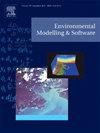一种高效的基于现代卷积的臭氧预测动态时空深度学习架构
IF 4.8
2区 环境科学与生态学
Q1 COMPUTER SCIENCE, INTERDISCIPLINARY APPLICATIONS
引用次数: 0
摘要
臭氧污染威胁着生态系统和人类健康,需要准确预测,以便更好地管理和执行政策。为了解决这个问题,我们开发了O3ConvNet,一个基于卷积的动态时空深度学习模型。它结合了ModernTCN,一个多变量时间序列特征模块,和一个使用动态邻接矩阵的空间消息传递模块,该模块具有地理和基于dtw的距离。O3ConvNet在不同站点密度和数据质量的数据集之间平衡性能和效率。洛杉矶地区1 ~ 24 h预测的平均绝对误差在6.984 ~ 15.990 μg/m3之间,R2值超过0.937。与最佳基线模型相比,计算时间减少了82%。在中国无锡,它将预测精度提高了18%,效率提高了81%。ModernTCN模块识别臭氧形成的关键因素,而动态邻接矩阵有助于有效地提取空间依赖性。总的来说,这项研究为区域臭氧预测引入了一个可靠和可推广的模式。本文章由计算机程序翻译,如有差异,请以英文原文为准。

An efficient modern convolution-based dynamic spatiotemporal deep learning architecture for ozone prediction
Ozone pollution threatens ecosystems and human health, necessitating accurate forecasting for better management and policy implementation. To address this, we developed O3ConvNet, a convolution-based dynamic spatiotemporal deep learning model. It incorporates ModernTCN, a multivariate time series feature module, and a spatial message passing module using a dynamic adjacency matrix with geographic and DTW-based distances. O3ConvNet balances performance and efficiency across datasets with varying station densities and data qualities. In Los Angeles, the mean absolute error ranges from 6.984 μg/m3 to 15.990 μg/m3 for 1-h to 24-h predictions, with R2 values exceeding 0.937. Computational time is reduced by up to 82% compared to the best baseline model. In Wuxi, China, it improves prediction accuracy by 18% and efficiency by 81%. ModernTCN module identifies critical factors for ozone formation, while the dynamic adjacency matrix helps extract spatial dependencies effectively. Overall, this study introduces a robust and generalizable model for regional ozone predictions.
求助全文
通过发布文献求助,成功后即可免费获取论文全文。
去求助
来源期刊

Environmental Modelling & Software
工程技术-工程:环境
CiteScore
9.30
自引率
8.20%
发文量
241
审稿时长
60 days
期刊介绍:
Environmental Modelling & Software publishes contributions, in the form of research articles, reviews and short communications, on recent advances in environmental modelling and/or software. The aim is to improve our capacity to represent, understand, predict or manage the behaviour of environmental systems at all practical scales, and to communicate those improvements to a wide scientific and professional audience.
 求助内容:
求助内容: 应助结果提醒方式:
应助结果提醒方式:


